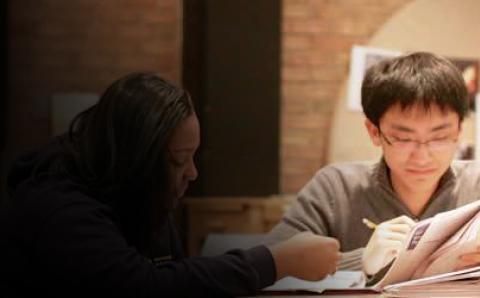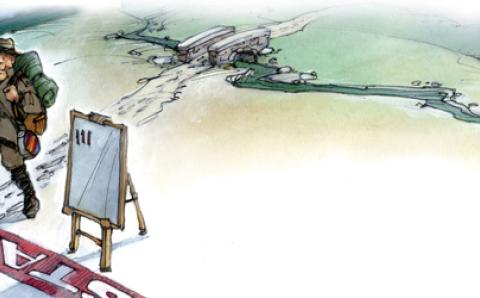When I was a young girl in the 1950s, I had terribly unrealistic notions about life and what it meant to live as an adult. I lived in a television utopia of perfectly happy families who seemed to have perfect lives: “Father Knows Best,” “Ozzie and Harriet,” and “Leave It to Beaver.” Back then I had every hope of having such a life myself. But now that I’m older, I think the movie Forrest Gump presents a more realistic picture: Life is like a box of chocolates; you never know what you’re going to get.
In 1975, author and retreat director Paula D’Arcy was a happy young woman married to a man she loved and the mother of a young daughter. She was pregnant with her second child. Life was good. Then she and her family were broadsided by the car of a drunk driver. Paula and her unborn child were the only ones who survived.
Teacher and writer Philip Simons was in the prime of his life with a great job and a beautiful family. He was diagnosed with ALS when he was 32 years old and died a slow and painful death.
In a hazy memory from years ago, I was standing in the dining room of my home when my husband came into the room carrying a suitcase and told me he was leaving. He then walked past me and out the front door. Our three children were sleeping upstairs. It’s taken me years to understand what happened in that marriage—and to honestly see my part in its end.
I tell you these stories not to horrify or depress you but to remind all of us that they are part of the reality of our lives and the lives of people around the globe. We are witnesses to the parade of death, loss, and grief every night on the evening news.
Many of us may escape horrible tragedies, but we all experience the smaller deaths of physical or emotional pain, struggle, disappointment, and loneliness. And we’re aware, at least on some level, that we will not get out of this life alive.
The Fruit of Suffering
What do we do with our suffering? How do we live with it or live through it? Those are the big questions. Life and death are mysteries too deep for the logical mind. They need to be uncovered through a myriad of experiences that gradually reveal their secrets. They need to be tenderly attended to with courage, patience, and compassion.
D’Arcy said of her experience, “I’d lived as though I had life figured out. The sudden death of my family . . . proved to me that I knew very little. All of us must ultimately find our way. Still, there are guideposts, small glimmers of light that direct all our journeys. In the end, the goal does not rest in being successful or even happy. It’s about finding a way through the layers of resistance that keep us frightened and small. Life creates an opening.”
And often this pondering—this searching for an opening, this agonizing wrestling—helps us to move from a life we never wanted to a life we never imagined.
Professor and author Marilyn McEntyre, in her article “What You Get for the Price,” tells the story of a rabbi “who, when a member of his congregation came to him rejoicing, would say, darkly, ‘How do you know it's not a disaster?’ On the other hand, when one came lamenting, he would ask, ‘How do you know it's not a blessing?’ . . . We don’t know what we’re being prepared for. We don’t know how things may work together for good. . . . It is the not knowing—the certainty that there is ‘a divinity that shapes our ends’ who is at work in ways we can't fathom—that opens us to surprise and invitation.”
Healing takes time; there are no shortcuts or quick fixes. There’s no cheap grace. But Henri Nouwen, the priest, teacher, and author who suffered bouts of depression, anxiety, and self-doubt , encourages us toward healing with these words: “The great challenge is loving your wounds through instead of thinking them through. It is better to cry than to worry, better to feel your wounds deeply than to understand them, better to let them into your silence than to talk about them.”
Healing is a creative work because the Spirit that makes an opening in us takes many forms. I found myself drawn out of grief by two friends who walked with me in the mornings; by the beauty and silence of the natural world; by my dog, who always makes me smile and who taught me to play; by going back to school; and by the spiritual director who listened to me as I tried to unpack what had happened to my life and where God was in the mess.
The Turning
In my earlier years, cooking inspired me and gave me joy and satisfaction; I even had a few professional gigs assisting well-known chefs who would come through town on book tours. Some days, when I was a single mom, I dreamed of escaping to France to study cooking. But life had fenced me in, and I often struggled just to get through the day. There was no success, no self-sufficiency anywhere. This time of emptiness, even though I was not fully aware of it then, helped create a hunger in me for God—not the God of my childhood who would protect me from all harm, but the One who would hold me in love no matter what.
Because of the pain of my divorce, I had deep questions that have turned into a search that never ends. I now spend much of my free time tracking down the best mystery ever—the mystery of dying and rising, of living and healing—with the help of authors from across the globe and through the ages who have written about exactly that. The Persian poet Rumi gifts me with his words “Through love all pain will turn to medicine.”
My community is large indeed, and I recognize my need for others. It is in our sharing life together that healing takes place. It seems to me that if we’re honest, we are all searching for wholeness in fractured lives.
Christians have a model for healing in the life of Jesus. Richard Rohr, in his book Falling Upward, writes, “The genius of the Gospel was that it included the problem inside the solution. The falling became the standing. The stumbling became the finding. The dying became the rising. The raft became the shore.” He refers to these as “the big patterns.”
Lent begins this month. It’s a season that invites us to notice the big patterns discovered on seemingly narrow roads—the roads of human life. The disciples did not understand this journey toward death, nor did they recognize Jesus traveling with them after the resurrection. We are walking the same confusing road, and now we wait for the dawn of a new day with Christ as our guide.
Let us, like him, give our complete trust to the One who loves us and accompanies us through good times and bad. And may this Lenten season break our hearts open to kindness and compassion for ourselves and others who suffer—so that we can walk with them and reflect back to them their beauty and worth, offering the gifts of hope and blessing.
Web Questions
- If you are a middle-aged or older adult, are you living the life you imagined when you were in your 20s? How different is your reality from your youthful dream? If you are a young adult, what do you anticipate your life might look like 10 or 15 years from now?
- How have you handled the disappointments and losses in your life? Is it possible to love your wounds, as Henri Nouwen suggests? Who or what has helped you to heal?
- Do you agree with the rabbi that a reason for lamenting can be a blessing and vice versa? Give an example to illustrate your point.
- Our culture—and often our church—teaches us that a successful life is one of health, wealth, and power. What is the gift of weakness or vulnerability?
- How important is honest struggle before God? How can it be expressed? In what ways does God respond?
- What “big pattern” have you discovered in your faith journey?
About the Author
Joyce Kane, a former Banner staff member, lives in Seattle, Wash.







